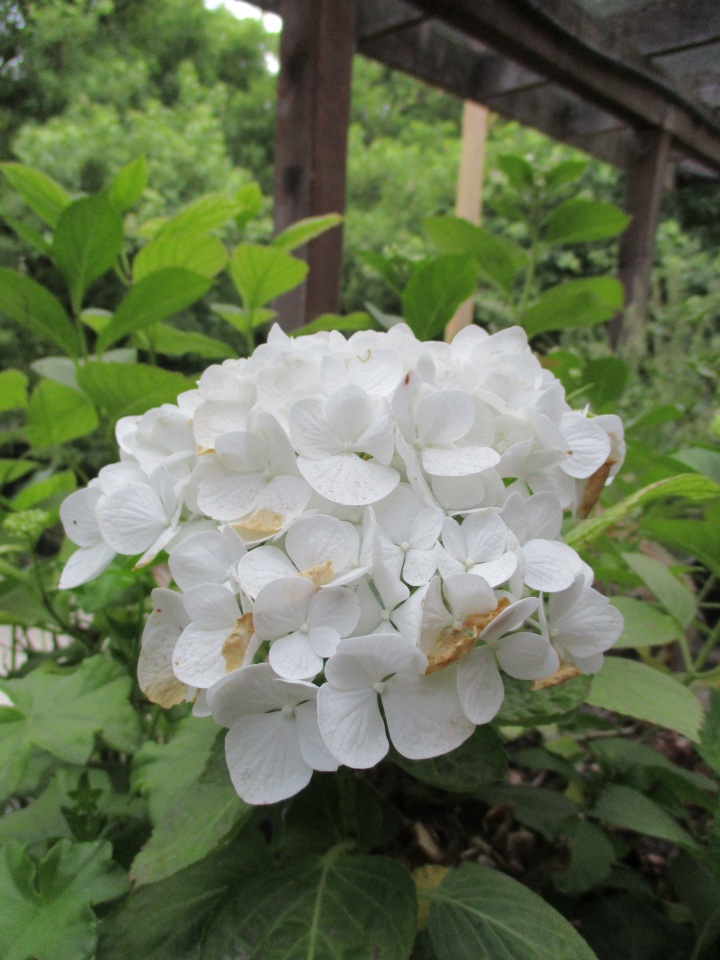 There are so many more of the fancier cultivars of hydrangea, Hydrangea macrophylla, than there were as recently as the 1990s. Many of the pink and blue hydrangeas were interchangeable years ago. They would bloom blue if the soil was acidic. They would bloom pink if the soil was alkaline. Their color changed accordingly when planted from potting media into soil of another pH.
There are so many more of the fancier cultivars of hydrangea, Hydrangea macrophylla, than there were as recently as the 1990s. Many of the pink and blue hydrangeas were interchangeable years ago. They would bloom blue if the soil was acidic. They would bloom pink if the soil was alkaline. Their color changed accordingly when planted from potting media into soil of another pH.
Most of the modern cultivars nowadays are better at one color or the other. Those that want to be rich pink or almost red might turn lavender or purple in acidic soil. Those that want to be rich blue might do the same in alkaline soil. That makes for many hues of pink, blue, lavender and purple. Most of those that bloom white always bloom white, and their foliage might be a little lighter green.
There is also much more variety in floral form than ever before, although all bloom in summer or autumn with big rounded or nearly spherical trusses of many small flowers. The deciduous leaves are about six inches long, and pleasantly lush and glossy. Modern compact cultivars stay low and dense. Larger cultivars get about six feet high and wide, with somewhat open branch structure.
We used to have massive hydrangeas with pink flowers on the south side of our current garden but they died long ago – one day I will replace them.
LikeLiked by 1 person
It seems to me that the older cultivars got bigger than the more contemporary types. I know that some of the contemporary types are compact, but even the big ones do not seem to be as big as the old ones that I remember seeing when I was a kid. They were popular under the porches of those tall Victorian homes in San Francisco, and they filled the spaces well, obscuring the foundations and any basement windows below.
LikeLike
My dad had a climbing hydrangea at the entrance to his house. He had no idea of gardening, and would chop it down now and again because it “got in the way”, but that hydrangea survived everything and would flower every year. Not forgetting that dad was then about 80-90 years old. He passed away 2 years ago at the age of 100 years 7 months. He had to move house when he was 95 for a care home, so I do not know if the hydrangea is still there.
LikeLiked by 1 person
Twenty years ago, while he was chopping down his established climbing hydrangea, they were just becoming popular here. There were none big enough to chop back yet.
LikeLike
Another shrub I love but can’t grow here. In NZ on the farm we had a hedge of blue hydrangea along one side of the garden. Looked stunning in full flower
LikeLiked by 1 person
The blue ones seem to be more striking to me, probably because I find the pink ones to be so common. They really stood out in the dark fir forests of Washington and Oregon. But of course, people in Washington and Oregon want pink hydrangeas.
LikeLiked by 1 person
Grandma didn’t understand chemistry, but she knew to put rusty nails in the ground when planting a hydrangea to make the flowers blue.
LikeLiked by 2 people
Well, she may have known the more important aspects of chemistry. It is ironic that people are much more educated than decades ago, but do not know how to use what they know.
LikeLiked by 1 person
That is ironic. She knew how to combine things to make soap, how to color hydrangeas, and make the world’s best sugar cookies among many other things. Grandma knew what she needed to know, and passed on so much wisdom. 😊
LikeLiked by 1 person
Thank you for this. My only concern with the hydrangeas is that they are deciduous — not very pretty for a front walk in the winter months! Otherwise, I love them!
LikeLiked by 1 person
They happen to be popular for front walkways and under porches for some reason. I remember that many of the old Victorian homes that were set back just a few feet from the sidewalks in San Francisco had the old big ones under the porches. They spread out over much of the available area, only to be cut back for the winter. I like hydrangeas out in unrefined landscapes that can get watered, but I do not understand why they are so popular for front porches and walkways.
LikeLiked by 1 person
Mine happened by accident. They were doing well in pots, and I needed something to put in the ground! They’ve thrived on neglect, and as much as I love them, I know they are in the wrong place!
LikeLiked by 1 person